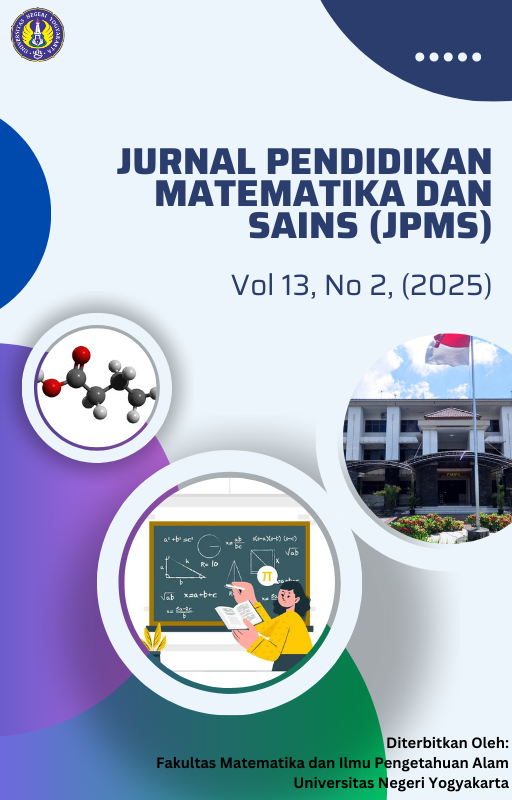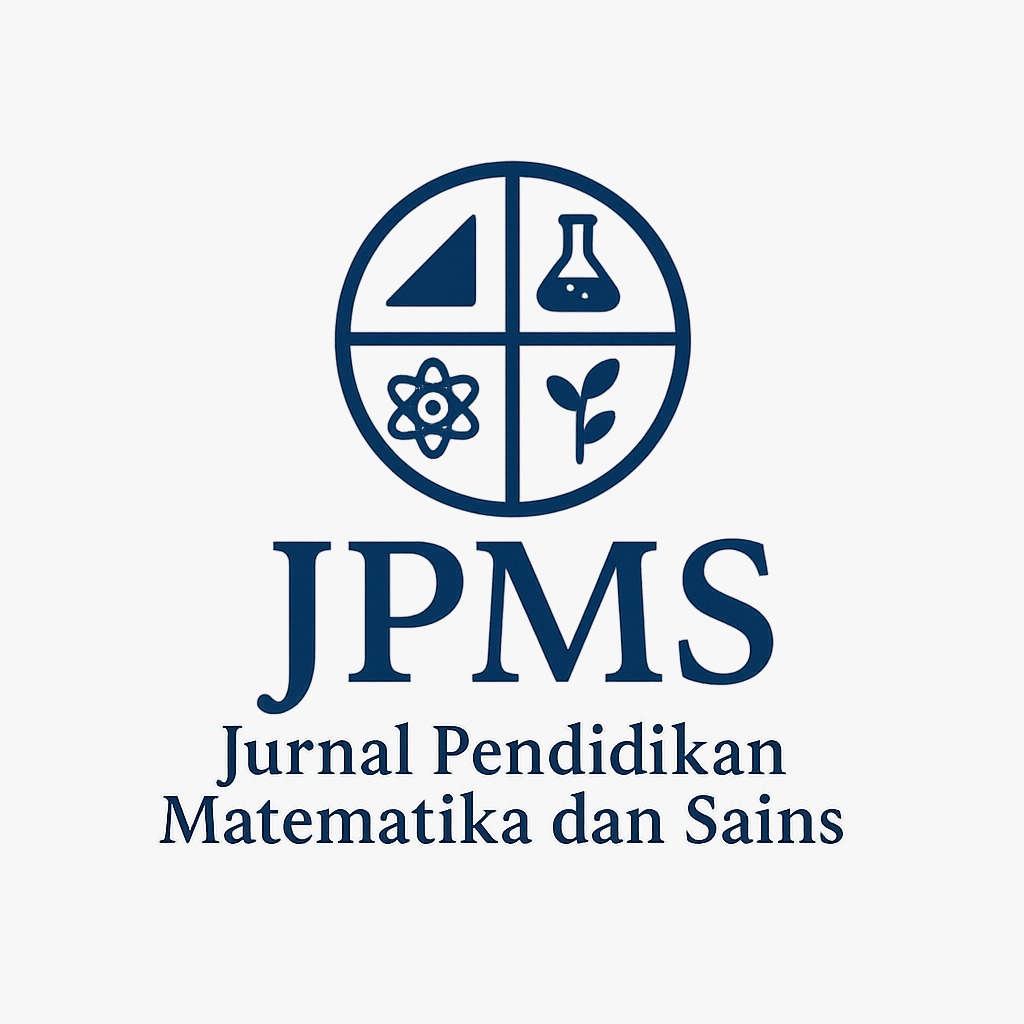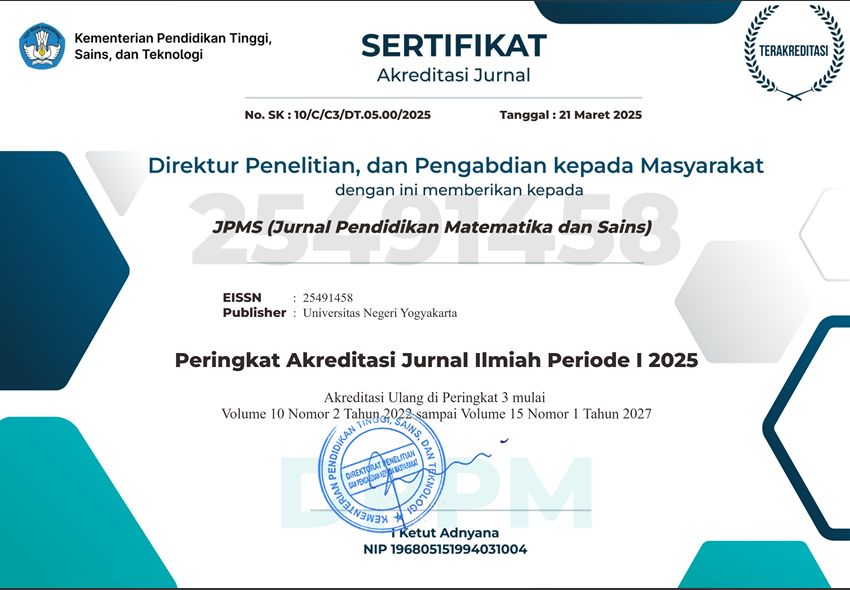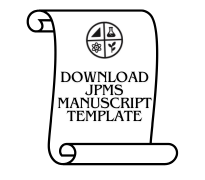Comparative Study of Students' Conceptual Understanding in Two Different Curricula on the Light and Electromagnetic Waves Materials
DOI:
https://doi.org/10.21831/jpms.v13i2.87915Keywords:
Light and Electromagnetic Waves,, Cambridge Curriculum, Merdeka Curriculum, Conceptual UnderstandingAbstract
Conceptual understanding involves a deep comprehension of a concept, including the ability to explain, illustrate, and apply it in various contexts. This study aims to compare students’ levels of conceptual understanding under the Kurikulum Merdeka and the Cambridge Curriculum. A comparative descriptive method with a mixed-methods approach was used, employing a six-tier diagnostic test, interviews, and classroom observations. The sample consisted of 60 students selected through purposive sampling. The results showed that students following the Kurikulum Merdeka had a higher percentage of scientific understanding (43.4%) compared to those in the Cambridge Curriculum (20.3%). These findings indicate that the effectiveness of instruction is influenced not only by the curriculum strategy but also by factors such as the timing between instruction and assessment, students’ confidence in their responses, and language barriers. Therefore, instructional approaches should be aligned with students’ cognitive readiness and contextual conditions to optimize conceptual understanding.
References
Adilah, N., Galvez, J., Suliyanah, S., & Deta, U. A. (2023). Analisis implementasi kurikulum cambridge pada salah satu sekolah internasional di jakarta. Jurnal Ilmu Pendidikan Dan Pembelajaran, 2(1), 48–64. https://doi.org/10.58706/jipp.v2n1.p48-64
Alatas, F., Setiawan, B. A., & Suryadi, A. (2024). The effect of prediction, observation, explanation, elaboration, write, and evaluation (POE2WE) learning model on student’s scientific communication skills on the sound wave concept. AIP Conference Proceedings (p. 1). Bandar Lampung: AIP Publishing.
Azzahrah Putri, R., Magdalena, I., Fauziah, A., & Nur Azizah, F. (2021). Pengaruh gaya belajar terhadap pembelajaran siswa sekolah dasar. Cerdika: Jurnal Ilmiah Indonesia, 1(2), 157–163. https://doi.org/10.36418/cerdika.v1i2.26
Cambridge Assesment International Education. (2019). International education from cambridge: What lies at the heart of our approach. Cambridge Assessment International Education, 1–16. https://www.cambridgeinternational.org/Images/417448-overview-brochure.pdf
Cummins, J. (2008). BICS and CALP: Empirical and theoretical status of the distinction. Encyclopedia of Language and Education, January 2008. https://doi.org/10.1007/978-0-387-30424-3
Dinurrohmah, S., & Pratomo, E. N. (2023). Does the merdeka curriculum potentially integrate with the cambridge curriculum? perspective through physics subject. Jurnal Literasi Pendidikan Fisika (JLPF), 4(2), 152–160.
Entino, R., Hariyono, E., & Lestari, N. A. (2021). Analisis miskonsepsi peserta didik sekolah menengah atas pada materi fisika. PENDIPA Journal of Science Education, 6(1), 177–182. https://doi.org/10.33369/pendipa.6.1.177-182
Febriyana, S. A., Liliawati, W., & Kaniawati, I. (2020). Identifikasi miskonsepsi dan penyebabnya pada materi gelombang stasioner kelas XI. Jurnal Fisika Dan Pendidikan Fisika, 5(2), 42–51.
Festiana Purwanti, P., Jufriadi, A., Dian Ayu, H., & Ikhsan Muhibudi, M. (2023). Pemanfaatan model problem based learning dalam upaya melatih penguasaan konsep dan keaktifan siswa materi gelombang bunyi dan cahaya. Jurnal Pembelajaran, Bimbingan, Dan Pengelolaan Pendidikan, 3(7), 578–596. https://doi.org/10.17977/um065v3i72023p578-596
Hakim, L., & Alatas, F. (2021). Scientific communication skills on mechanical wave concept using student facilitator and explaining model assisted schoology. Journal of Physics: Conference Series, 1836, 1–8. https://doi.org/10.1088/1742-6596/1836/1/012064
Hidayat, M. (2011). Mengatasi miskonsepsi pada mata pelajaran fisika. Journal PFMIPA FKIP Universitas Jambi, 53(9), 1689–1699.
Ilyas, A., & Saeed, M. (2018). Exploring teachers’ understanding about misconceptions of secondary grade chemistry students. International Journal for Cross-Disciplinary Subjects in Education, 9(1), 3323–3328. https://doi.org/10.20533/ijcdse.2042.6364.2018.0444
Isma, A. I., & Nurlaela, A. (2024). The influence of cognitive apprenticeship learning models on students’ problem-solving skills in optical instruments. AIP Conference Proceedings (p. 1). Bandar Lampung: AIP Publishing.
Isra, R. A., & Mufit, F. (2023). Students’ conceptual understanding and causes of misconceptions on newton’s law. International Journal of Evaluation and Research in Education, 12(4), 1914–1924. https://doi.org/10.11591/ijere.v12i4.25568
Jannah, N. N., Liliawati, W., Muslim, M., & Aditya, N. (2022). Identification of physical misconceptions and their causes using five-tier kinematics test (Ftkt) on high school students. Journal of Teaching and Learning Physics, 7(1), 42–53. https://doi.org/10.15575/jotalp.v7i1.11282
Kaewkhong, K., Mazzolini, A., Emarat, N., & Arayathanitkul, K. (2010). Thai high-school students’ misconceptions about and models of light refraction through a planar surface. Physics Education, 45(1), 97–107. https://doi.org/10.1088/0031-9120/45/1/012
Kaltakci-Gurel, D., Eryilmaz, A., & McDermott, L. (2017). Development and application of a four-tier test to assess pre-service physics teachers' misconceptions about geometrical optics. Research in Science & Technological Education, Volume 35, Issue 2, 238-260.
Kamiliyah, Z., & Faruk, R. (2023). Merdeka curriculum better than K13 curriculum? Noumerico: Journal of Technology in Mathematics Education, 1(2), 56–63. https://doi.org/10.33367/jtme.v1i2.3499
Kurniasari, N., Permadi, I., & Purbasari, K. H. (2024). Refleksi guru pada pembelajaran berdiferensiasi di sekolah dasar. Jurnal Riset Pendidikan Dasar (JRPD), 5(2), 187. https://doi.org/10.30595/jrpd.v5i2.21877
Kusuma, W., Dwi Sundari, P., Hufri, & Hidayat. (2024). Students’ misconceptions and the causes on straight motion materials using six-tier multiple choice. Pillar of Physics Education, 11(4), 45–53. https://doi.org/10.29303/jppipa.v9i4.2001
Merlina. (2021). Identifikasi miskonsepsi peserta didik menggunakan metode tes diagnostik five-tier pada materi termodinamika (penelitian deskriptif di SMA negeri 1 ciseeng). In Repository UIN Syarif Hidayatullah Jakarta. UIN Syarif Hidayatullah Jakarta.
Mufit, F., & Karzah, K. (2024). Concept understanding and causes of student misconceptions on simple harmonic motion. JIPF (Jurnal Ilmu Pendidikan Fisika), 9(3), 464–473.
Murre, J. M. J., & Dros, J. (2015). Replication and analysis of ebbinghaus’ forgetting curve. PLoS ONE, 10(7), 1–23. https://doi.org/10.1371/journal.pone.0120644
Nainggolan, J., Silaban, B., Sinaga, D., & Zendrato, F. (2023). Analysis of physics misconceptions of students in mechanic materials using the tier multiple choice diagnostic test. AL-ISHLAH: Jurnal Pendidikan, 15(3), 3578–3586. https://doi.org/10.35445/alishlah.v15i3.3023
Nasir, M., Cari, C., Sunarno, W., & Rahmawati, F, . (2021). Article diagnostic difficulties and misconceptions of light refraction: A need analysis learning abstract concepts using PhET simulation. International Joint Conference on Science and Engineering 2021 (IJCSE 2021), 209(1), 317–322. https://www.atlantis-press.com/proceedings/ijcse-21/125966549
Ndihokubwayo, K., Uwamahoro, J., Ndayambaje, I., & Ralph, M. (2020). Light phenomena conceptual assessment: An inventory tool for teachers. Physics Education, 55(3). https://doi.org/10.1088/1361-6552/ab6f20
Nurmawati, S. (2022). Pengembangan instrumen diagnostik three tier untuk mengidentifikasi miskonsepsi siswa pada konsep cahaya. In UIN Fatmawati Sukarno Bengkulu. UIN Fatmawati Sukarno Bengkulu.
Nurulwati, Veloo, & Ruslan. (2014). Suatu tinjauan tentang jenis-jenis dan penyebab miskonsepsi fisika. Jurnal Pendidikan Sains Indonesia, 02(01), 87–95.
Pasaribu, M., Nurjannah, & Miftah. (2023). Misconception level analysis of prospective physics teacher students in geometric optic using multiple-misconception revealing test. VII(2454), 702–720. https://doi.org/10.47772/IJRISS
Permana Suwarna, I. (2013). Analisis miskonsepsi siswa SMA Kelas X pada mata pelajaran fisika melalui CRI (certainty of response index) Termodifikasi. Repository UIN Syarif Hidayatullah Jakarta, 1–14.
Putri, W. O., Maria, H. T., & Hamdani, H. (2021). Analisis miskonsepsi menggunakan four tier diagnostic test berbantuan google form pada materi tekanan zat. Edukatif : Jurnal Ilmu Pendidikan, 3(6), 4738–4749. https://doi.org/10.31004/edukatif.v3i6.1445
Radiusman, R. (2020). Studi literasi: Pemahaman konsep anak pada pembelajaran matematika. FIBONACCI: Jurnal Pendidikan Matematika Dan Matematika, 6(1), 1. https://doi.org/10.24853/fbc.6.1.1-8
Rahayu, W. I., Najiah, M., & Nulhakim, L. (2022). Komponen dan model pengembangan kurikulum pendidikan. Jurnal Pendidikan Dan Konseling, 4(6), 1349–1358.
Rahmawati, S. (2024). Analisis miskonsepsi siswa sekolah menengah atas (SMA) menggunakan soal isomorfik pada materi gelombang bunyi. In Repository UIN Syarif Hidayatullah Jakarta. UIN Syarif Hidayatullah Jakarta.
Resbiantoro, G., Setiani, R., & Dwikoranto. (2022). A review of misconception in physics: the diagnosis, causes, and remediation. Journal of Turkish Science Education, 19(2), 403–427. https://doi.org/10.36681/tused.2022.128
Rokhim, D. A., Widarti, H. R., & Sutrisno. (2023). Five-tier instrument to identify students’ misconceptions and representation: A systematic literature review. Orbital, 15(4), 202–207. https://doi.org/10.17807/orbital.v15i4.17709
Safitri, N. S., Djudin, T., & Trisianawati, E. (2020). Identifkasi miskonsepsi siswa pada materi kalor dan perpindahannya di kelas VII SMP negeri 5 sungai kakap. Jurnal Pendidikan Sains Dan Aplikasinya, 3(1), 1–6.
Sari, K. (2018). Miskonsepsi pembelajaran fisika pada konsep gerak lurus di SMA negeri 1 baitussalam aceh besar. Jurnal Serambi PTK, 5(2), 24–29. ojs.serambimekkah.ac.id
Setiawan, D., & Faoziyah, N. (2020). Development of a five-tier diagnostic test to reveal the student concept in fluids. Physics Communication, 4(1), 6–13. http://journal.unnes.ac.id/nju/index.php/pc
Stankov, L., Lee, J., Luo, W., & Hogan, D. J. (2012). Confidence: A better predictor of academic achievement than self-efficacy, self-concept and anxiety? Learning and Individual Differences, 22(6), 747–758. https://doi.org/10.1016/j.lindif.2012.05.013
Sugiyono. (2023). Metode penelitian pendidikan (pendekatan kuantitatif, kualitatif dan R&D (2nd ed.). Bandung: Alfabeta.
Suryadi, A., Yuliati, L., & Wisodo, H. (2021). The effect of STEM-based phenomenon learning on improving students’ correlational reasoning. AIP Conference Proceedings, 2330(Maret). https://doi.org/10.1063/5.0043639
Triwibowo, F., & Sucahyo, I. (2017). Sistem alat ukur intensitas cahaya tampak bebasis aduino uno dengan akusisi data menggunakan sotware parallax data acquisition. Jurnal Inovasi Fisika Indonesia (IFI), 06(3), 53–58. https://jurnalmahasiswa.unesa.ac.id/index.php/inovasi-fisika-indonesia/article/view/20337
Utami, A. W., & Khotimah, S. N. (2023). Identification of students’ misconceptions using six tier diagnostic test with CRI (certainty of response index) on Wave. Jurnal Penelitian Pendidikan IPA, 9(7), 5205–5213. https://doi.org/10.29303/jppipa.v9i7.4192
Wahyudin, D., Subkhan, E., Malik, A., Hakim, M. A., Sudiapermana, E., LeliAlhapip, M., Nur Rofika Ayu Shinta Amalia, L. S., Ali, N. B. V., & Krisna, F. N. (2024). Kajian akademik kurikulum merdeka. Kemendikbud, 1–143.
Widiarini, P. (2020). Profil Miskonsepsi Mahasiswa Calon Guru Fisika Pada Konsep Gaya. Wahana Matematika Dan Sains: Jurnal Matematika, Sains, Dan Pembelajarannya., 14(1), 203–214.
Yolviansyah, F., Siregar, J., & Maison. (2022). The relationship of critical thinking skills and misconceptions on science learning. Thinking Skills and Creativity Journal, 5(2), 52–61. https://doi.org/10.23887/tscj.v5i2.45465
Downloads
Published
How to Cite
Issue
Section
Citation Check
License

This work is licensed under a Creative Commons Attribution-ShareAlike 4.0 International License.
Jurnal Pendidikan Matematika dan Sains allows readers to read, download, copy, distribute, print, search, or link to its articles' full texts and allows readers to use them for any other lawful purpose. The journal allows the author(s) to hold the copyright without restrictions. Finally, the journal allows the author(s) to retain publishing rights without restrictions
- Authors are allowed to archive their submitted article in an open access repository
- Authors are allowed to archive the final published article in an open access repository with an acknowledgment of its initial publication in this journal

This work is licensed under a Creative Commons Attribution-ShareAlike 4.0 Generic License.





